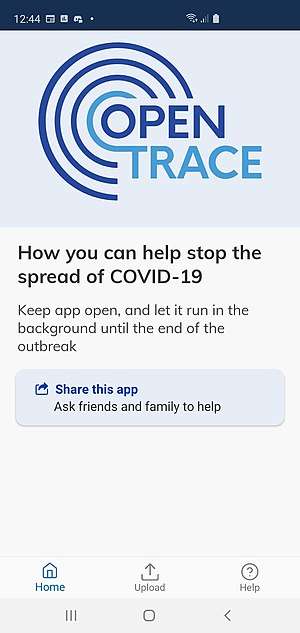TraceTogether
TraceTogether is an app released by the Singaporean Government that allows for digital contact tracing using the custom BlueTrace protocol.[1][2] The app was developed by the Government Technology Agency and released on 20 March 2020. Since the release of the app the percentage of the population have downloaded it has gone up gradually. As of 10 Aug, there were over 2,300,000 downloads, meaning over 42% of the population had downloaded it.[3][4] Downloading, installing and activating (registering) the app has been made mandatory for high risk populations by the government,[5][6] and government employees have been pressed into installing the app, with some agencies making it mandatory. The app and protocol were also open sourced as OpenTrace and BlueTrace respectively.
 | |
Screenshot  | |
| Developer(s) | Government Technology Agency |
|---|---|
| Repository | |
| Written in |
|
| Operating system | Android, iOS |
| Licence | GPL-3.0 |
| Website | www |
Description
TraceTogether adopts a distributed approach where participating devices exchange proximity information whenever an app detects another device with the TraceTogether app installed.[7]
To trace users the Ministry of Health (MOH) issues time sensitive anonymous temporary IDs that are used to identify the patient to all third parties. When two users of the app pass by, it uses the Bluetooth Relative Signal Strength Indicator (RSSI) readings between devices across time to approximate the proximity and duration of an encounter between two users. This proximity and duration information is stored on one's phone for 21 days on a rolling basis.[7] Once a user tests positive for infection, the MOH works with them to map out their activity for past 14 days and requests the contact log. The user cannot legally refuse to share it.[8]
Effectiveness of the app
By 10 Aug 2020, 42% of the population had installed the application, up from 17% of the population in May 2020, which had previously limited the usefulness of the application.[3][9] The usage of the app had been limited by the technical limitations of needing to have the application to run in the foreground on iOS devices, and battery drain,[10] but these problems had been addressed in the 2.1 version of the app released on 3 July 2020, and version 2.1.3 of 5 Aug added informational, work pass and SafeEntry QR features.[11] The authorities are issuing wearable devices, TraceTogether Token, as a complementary addition to the application end of June 2020.[12]
Usage
TraceTogether is convenient and easy-to-use. Simply download the app, enter the phone number (Step 1), grant the app permissions (Step 2), turn on Bluetooth (Step 3) and leave the app running (Step 4).[13]
Privacy and Data
TraceTogether is explicitly designed from conception to preserve the privacy of users from each other,[14] but in contrast to alternative approaches favoured in other countries, is not anonymous as participants have to register the app using their phone number and national registration number or other evidence of residency. In order to safeguard participant's mutual privacy and ensuring their control over the data Trace Together:[15]
- Stores limited data. Data over 25 days old is deleted automatically. When signing up, a random User ID is generated and associated with the mobile number. Both the mobile number and User ID are stored in a secure server, and never shown to the public. All data from or about other phones will never be accessed, unless the user has been in close contact with a COVID-19 case and is contacted by the contact tracing team.
- Does not collect data about location (GPS or Wi-Fi). TraceTogether uses Bluetooth to approximate distance to other nearby phones running the same app.
- Creates temporary IDs that change regularly. The lack of a persistent identifier means it is impossible for third parties to identify or track users.
- Allows consent revoking at any time. If a user opts out, their contact information is deleted from the MOH, meaning any log entries they appear in can no longer be matched with them.[14] Users are only able to request opt-out via an email to a government agency.[16]
- Prompts disabling TraceTogether's functionality once contact tracing ceases.
References
- "Home". bluetrace.io. Retrieved 2020-04-12.
- Sharwood, Simon. "Singapore to open-source national Coronavirus encounter-tracing app and the Bluetooth research behind it". www.theregister.co.uk. Retrieved 2020-04-12.
- "Wayback Machine (to 2.3 MM on 10Aug2020)". web.archive.org. Retrieved 10 August 2020.
- "TraceTogether - Google Play Store - multiple dates". Retrieved 2020-04-13.
|archive-url=is malformed: timestamp (help) - "COVID-19: New app launched to help monitor and report migrant workers' health status". Retrieved 2020-06-05.
- "All foreign workers have to download and activate TraceTogether app by June 19: MOM". Retrieved 2020-06-17.
- "How does TraceTogether work?". Government Technology Agency. Retrieved 2020-05-31.
- "Can I say no to uploading my TraceTogether data when contacted by the Ministry of Health?". Government Technology Agency. Retrieved 2020-05-28.
- "Only 17% of Singapore population downloaded TraceTogether app, experts urge to make it mandatory". The Online Citizen. 2020-05-05. Retrieved 2020-05-30.
- "Singapore to launch TraceTogether Token device for COVID-19 contact tracing". MobiHealthNews. 2020-06-10. Retrieved 2020-06-18.
- "TraceTogether". apps.apple.com. Retrieved 29 July 2020.
- hermesauto (2020-06-08). "Covid-19 contact tracing device will not be an electronic tag, to be rolled out in June". The Straits Times. Retrieved 2020-06-18.
- "Help speed up contact tracing with TraceTogether". www.gov.sg. Retrieved 2020-05-31.
- Jason Bay, Joel Kek, Alvin Tan, Chai Sheng Hau, Lai Yongquan, Janice Tan, Tang Anh Quy. "BlueTrace: A privacy-preserving protocol for community-driven contact tracing across borders" (PDF). Government Technology Agency. Retrieved 2020-04-12.CS1 maint: multiple names: authors list (link)
- "TraceTogether Privacy Safeguards". Government Technology Agency. Retrieved 2020-05-31.
- "How can I stop sharing my data?". Government Technology Agency. Retrieved 2020-05-28.